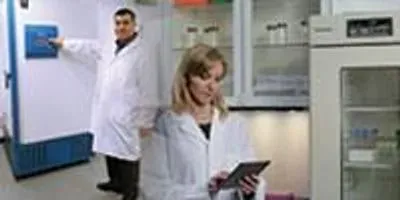
Frost, filters and voltage are the main things to watch
“For home fridges, it’s not something that people are concerned with, but for cold storage freezers, removing the frost [is important] because it will affect uniformity, energy consumption, and possibly product viability long-term if [users] don’t remove it,” says Joe LaPorte, director of product management at PHC Corporation of North America.
LaPorte adds that frost should be removed when it becomes too thick to see the inside walls of the unit. Many freezers and fridges also have indicators that show when it’s time to deal with frost, and having difficulty closing the inner or outer door of an ultralow freezer is another sign to get scraping, LaPorte says.
Having the correct voltage for your unit is also essential.
“Unstable voltage may cause malfunction of freezers, thus voltage must be provided at less than plus or minus the five percent range,” says Jean Fallacara, CEO of Z-SC1 Biomedical. “Power supply must be 25 percent higher than required.”
The surrounding environment also plays a role.
“Temperature and humidity affect the performance of freezers, thus the environment must be maintained within the recommended conditions,” Fallacara says. “Crowded rooms will tend to overheat and the equipment along with it.” Those optimal conditions are from 5-25°C, ideally 20°C, with lower than 50 percent relative humidity (RH).
Both LaPorte and Fallacara stress users should ensure they keep enough space around the unit and don’t store anything on top of it so air can properly circulate.
Cleaning the filters on a regular basis is also necessary.
“If it’s in a common area, [the filter] typically has to be cleaned more often than in a quiet laboratory environment,” LaPorte explains. He adds lab workers should consider using the switchover to and from daylight savings time as a guide for when to clean filters. “It [cleaning filters] usually only takes, for each piece of equipment, less than a minute to do it but it can make all the difference for equipment performance.”
Fallacara agrees that changing filters is important, however, he also points out that the latest generation of freezers is filter-free, meaning users can avoid this task.
In general, Fallacara says users should do maintenance at least twice a year.
“This all depends on where the equipment is placed, ambient temperatures, and humidity,” he says. “Also how often the fridge or freezer doors are opened during a day [is a factor].”
Common mistakes in fridge and freezer maintenance, apart from not regularly taking care of the frost and filters, include cleaning the freezer while it is up, running, and connected to a power supply; overloading the unit; using non-dedicated electrical circuits; and ignoring vertical and horizontal installation requirements.
Both LaPorte and Fallacara add that leaving the unit’s door open too long when removing ice is another common error.
“You try to move as quickly as possible so that you’re not affecting the temperature inside the unit,” LaPorte says.
Strange noises, vibrations, or alarms going off are signs you should probably inspect your unit. However, LaPorte cautions that it’s not a good idea to wait for some alarms to go off before doing maintenance.
“A lot of equipment, including ours, has a filter sensor on it, but that filter sensor really isn’t an indication that you should clean your filter,” he explains. “It’s more of an indication that it’s gotten to such a severe level that you really need to address it now.”
What You Should Know Before Signing Up For a Fridge/Freezer Maintenance Program - Ask about the technician’s installation methods
- Make sure you find out how much time will be spent when technicians make a maintenance call, as this accounts for a large portion of the cost
- What is the response time when an emergency repair call is made?
- Are backup units available if repairs are needed?
- If your samples are critical, 24/7 monitoring is usually a good service to have
- Often, maintenance programs are run by regional service providers; make sure they are qualified
|
For that reason, users should make sure they understand what all of the indicators and alarms on their unit mean by reading the user’s manual and consulting with technical support. Fallacara adds that, in addition to those resources, the freezer engineer can be a good source of education for users at the time of installation and the Internet is always useful.
In the end, following a regular maintenance schedule and ensuring the environment is ideal are the main things users should focus on.
“[Users] just have to stick to a schedule and a step-by-step protocol with checkboxes,” Fallacara recommends. “Have a schedule for stocking and cleaning out the fridges and freezers, [as] this [will] avoid long periods of door openings.”
Frost, filters and voltage are the main things to watch
“For home fridges, it’s not something that people are concerned with, but for cold storage freezers, removing the frost [is important] because it will affect uniformity, energy consumption, and possibly product viability long-term if [users] don’t remove it,” says Joe LaPorte, director of product management at PHC Corporation of North America.
LaPorte adds that frost should be removed when it becomes too thick to see the inside walls of the unit. Many freezers and fridges also have indicators that show when it’s time to deal with frost, and having difficulty closing the inner or outer door of an ultralow freezer is another sign to get scraping, LaPorte says.
Having the correct voltage for your unit is also essential.
To continue reading this article, sign up for FREE to

Membership is FREE and provides you with instant access to eNewsletters, digital publications, article archives, and more.












